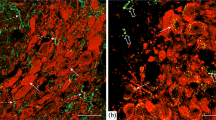Immunoreactive processes containing agouti-regulated protein (AGRP) were detected in various dopaminergic structures in the brains of rats and mice. Double immunolabeling demonstrated the presence of AGRP-immunoreactive processes around the bodies of dopaminergic neurons. In in vitro experiments, incubation of brain tissue from the ventral tegmental area and hypothalamus with AGRP(83-132) identified significant reductions in the optical density of tyrosine hydroxylase. These data provide evidence of the possible direct inhibitory effect of AGRP on the level of tyrosine hydroxylase in dopaminergic neurons and of its role as a modulator of the functional activity of dopaminergic neurons.
Similar content being viewed by others
References
N. M. Bazhan, E. N. Makarova, A. Yu. Shevchenko. And T. V. Yakovleva, “Repeated emotional stress prevents the development of melanocortin obesity and type 2 diabetes in mice with the Agouti yellow mutation,” Ros. Fiziol. Zh., 93, No. 11, 560–566 (2007).
E. N. Makarova, A. Yu. Shevchenko, T. V. Yakovleva, and N. M. Bazhan, “Pregnancy and lactation prevent the development of melanocortin obesity syndrome in mice with the Agouti yellow mutation,” Dokl. Adak. Nauk., 407, No. 3, 426–429 (2006).
G. A. Oganesyan, E. A. Aristakesyan, I. V. Romanova, et al., “The dopaminergic nigrostriatal system in conditions of sleep deprivation in rats,” Ros. Fiziol. Zh., 93, No. 12, 1344–1354 (2007).
I. V. Romanova, “Morphofunctional interaction of CART peptide and dopaminergic neurons in the brain,” Zh. Evolyuts. Biokhim. Fiziol., 49, No. 1, 78–84 (2013).
M. V. Ugryumov, Mechanisms of Neuroendocrine Regulation, Nauka, Moscow (1999).
A. R. Heryet and K. S. Gatter, “Immunocytochemistry: light microscopy,” in: Molecular Clinical Diagnosis. Methods [Russian translation], Mir, Moscow (1999), pp. 20-65.
D. Bagnol, X. Y. Lu, C. B. Kaelin, et al., “Anatomy of an endogenous antagonist: relationship between agouti-related protein and proopiomelanocortin in brain,” J. Neurosci., 19, 1–7 (1999).
N. Ben-Jonathan, M. A. Neill, L. A. Arbogast, et al., “Dopamine in hypophyseal portal blood: relationship to circulating prolactin in pregnant and lactating rats,” Endocrinology, 106, 690–696 (1980).
M. M. Bradford, “A rapid and sensitive method for the quantitation of microgram quantities of protein utilizing the principle of proteindye binding,” Anal. Biochem., 72, 248–254 (1976).
C. Charbonneau, F. Bai, B. S. Richards, and G. Argyropoulos, “Central and peripheral interactions between the agouti-related protein and leptin,” Biochem. Biophys. Res. Commun., 319, No. 2, 518–524 (2004).
A. P. Goldstone, U. A. Unmehopa, S. R. Bloom, and D. F. Swaab, “Hypothalamic NPY and agouti-related protein are increased in human illness but not in Prader-Willi syndrome and other obese subjects,” J. Clin. Endocrinol. Metab., 87, No. 2, 927–937 (2002).
K. Goto, A. Inui, Y. Takimoto, et al., “Acute intracerebroventricular administration of carboxyl-terminal fragments of agouti-related peptide produces a long-term decrease in energy expenditure in rats,” Int. J. Mol. Med., 12, 379–383 (2003).
C. Haskell-Luevano, P. Chen, C. Li, et al., “Characterization of the neuroanatomical distribution of agouti-related protein immunoreactivity in the rhesus monkey and the rat,” Endocrinology, 130, No. 3, 1408–1415 (1999).
P. Jourdain, B. Dupouy, R. Bonhomme, et al., “Visualization of local afferent inputs to magnocellular oxytocin neurons in vitro,” Eur. J. Neurosci., 11, 1960–1972 (1999).
U. K. Laemmli, “Cleavage of structural proteins during the assembly of the head of bacteriophage T4,” Nature, 227, No. 5259, 680–685 (1970).
E. N. Makarova, T. V. Yakovleva, and A. Y. Shevchenko, “Pregnancy and lactation have antiobesity and anti-diabetic effects in Ay/a mice,” Acta Physiologica, 198, No. 2, 169–177 (2010).
M. M. Ollman, B. D. Wilson,Y. K. Yang, et al., “Antagonism of central melanocortin receptors in vitro and in vivo by agouti-related protein,” Science, 278, 135–138 (1997).
G. Paxinos and C. Watson, The Rat Brain in Stereotaxic Coordinates, Academic Press, San Diego (1998), ISBN 0-12-547617-5.
G. T. Paxinos and K. B. J. Franklin, The Mouse Brain in Stereotaxic Coordinates, Academic Press, San Diego (2001), 2nd ed.
L. E. Pritchard and A. White, “Agouti-related protein: More than a melanocortin-4 receptor antagonist?” Peptides, 26, 1759–1770 (2005).
V. Tolle and M. J. Low, “In vivo evidence for inverse agonism of agouti-related peptide in the central nervous system of proopiomelanocortin- deficient mice,” Diabetes, 57, No. 1, 86–94 (2008).
Y. K. Yang, M. Ollmann, B. Wilson, et al., “Effects of recombinant agouti-signaling protein on melanocortin action,” Mol. Endocrinol., 11, 274–280 (1997).
Author information
Authors and Affiliations
Corresponding author
Additional information
Translated from Rossiiskii Fiziologicheskii Zhurnal imeni I. M. Sechenova, Vol. 99, No. 9, pp. 1036–1044, September, 2013.
Rights and permissions
About this article
Cite this article
Mikhrina, A.L., Romanova, I.V. The Role of AGRP in Regulating Dopaminergic Neurons in the Brain. Neurosci Behav Physi 45, 536–541 (2015). https://doi.org/10.1007/s11055-015-0107-7
Received:
Revised:
Published:
Issue Date:
DOI: https://doi.org/10.1007/s11055-015-0107-7



